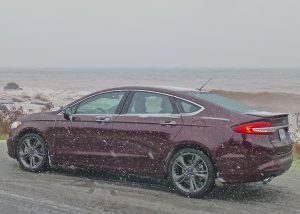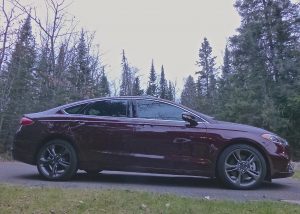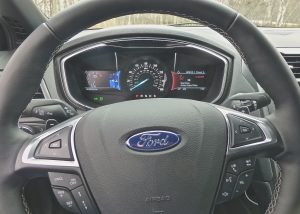New Fusion adds flair with Sport model
When the Ford Fusion was first introduced, I thought it was the most appealing design ever slapped onto the sheetmetal of a Detroit sedan. It still stirs the senses when one drives by.
For 2017, it was time for a major revision and upgrading of the Fusion, and Ford has done the job well. Particularly well, in the case of the Fusion Sport, which is a high-performance version of the venerable family sedan.
As a member in good standing of the midsize segment, which has come under heavy pressure from the enlarging gang of compacts below and the larger crossover SUVs coming at it from above. But the best midsize cars hold their own well, including the Accord, Camry, Mazda6, Altima, Sonata, Optima, Malibu, and Passat sedans == and the Fusion is right in there.
The Sport, however, is something else. Not since Ford made a top-level Taurus in high-performance SHO form has the company made such a stirring everyday driver as the Fusion Sport.
In keeping with Ford’s concept of downsizing in the engine bay, to let V6es do the job of V8s, and hot 4s replace V6es, the Fusion Sport makes top use of its EcoBoost plan to replace a solid engines with an enlivened but smaller engine, turbocharged to jack-up performance.
The garden-variety Fusion comes with your choice of a 1.5 or 2.0 liter 4-cylinders, where the 2.0 can be turbocharged to meet EcoBoost standards, plus there’s a hybrid that adds an electric motor to the 2.0’s output. Or, you can move up to the Sport.
That gets you some subtle trim touches, a neat interior, slick wheels that are 19-inchers, sportier suspension, and two major features that should leave the more mundane members of the competition wheezing and looking at the Fusion Sport’s quad tailpipes.
One of those is a twin turbocharged 2.7-liter EcoBoost V6. The 2.7 gets twin turbochargers to boost — literally — power up to 325 horsepower and 380 foot-pounds of torque. All that power makes great use of the other major feature — all-wheel drive.
Back when the Taurus SHO came out, it was powered by a Yamaha built 3.0-liter V6 that had fantastic power and made the car a true sports sedan, albeit with front-wheel drive. It was worthy of running up against the best European sports sedans.
A good friend of mine, who had lusted for a high-performance car from teenage years up to middle age, bought an SHO and loved it. He had one that had some problems, but he loved it all the same for its shrill sound of power. He later switched through a couple of Mustangs, and now he’s up to a late model Fusion.
I’m going to have to suggest he should go back and test-drive a new Fusion Sport, because I know it’s going to stir the old juices in him all over again.
The test car I drove arrived amid a mixture of dry but chilly weather and a couple of snowstorms along the North Shore of Lake Superior, which made things interesting. The Fusion Sport was an outstanding sports sedan in the dry, cornering on the proverbial dime and steering with razor-sharp precision.
All the interior features were there, too, including a changeable instrument panel, firmly supportive seats, good room in the rear seat, and a sizeable trunk. It also has setting to upgrade the steering and suspension to sportier tastes, but was never harsh over road irregularities.

The start of a North Shore snowstorm was no hassle for the Fusion Sport and its all-wheel drive distribution of power.
Then it snowed on the North Shore, and it was with a considerable feeling of security that I ventured down to a couple of parking areas along the shore to watch the waves come a-crashing, while snow flurries filled the air. The all-wheel drive made the Fusion Sport convert nicely from all-out sports sedan to trusty weather-beater.
The 6-speed automatic shifted as hard as you wanted, and the turbo’s responsive 380 foot-pounds sent the Taurus Sport off with great force any time you wanted to depart in a hurry.
Technical features always have put the Fusion at the head of the class, even though a few of the SYNC system’s early years were met with hot and cold reception. There always was an interesting irony when I learned that JD Powers rated the SYNC connectivity as enough of a nuisance-problem-filled device to lower its initial quality number from among the best to among the worst. Then I learned that buyers complained about the complexity of operating the SYNC system — but they demanded to have it on the cars they bought.
In other words, it might have been complex, but it also was on the leading edge of auto technology. The newest SYNC system worked flawlessly during my week-long test drive, and was simple to operate.
My biggest complaint was that while the power of the turbocharged 2.7 was as good if not better than most V6 or V8 engines, the fuel economy was also no big leap of improvement over such larger powerplants. I would settle for dialing the power back a little and increasing the fuel economy by 5.
The Sport with all its added features costs $40,000, although adding the trick wheels and the engine, transmission, suspension, steering benefits of the upgrades make it worth a larger investment, because it pays you back every time you climb behind the wheel.
As for extra features, everybody knows about back-up cameras and lane-departure warning and blind-spot detection, and we like all those benefits. But how about an electronic system that includes a pothole detection capability?
That’s right; If you’re driving along on your winter-ravaged asphalt roadway and you come upon a terrible chuckhole, as your tire starts to drop down into the crevasse, the computer reads the abrupt move and reduces the impact severity of the tire hitting the far edge of asphalt.
Now there’s a feature that should rank right up there with autostart, keyless entry, and all the rest. The Fusion Sport is the only Fusion that has that device, which is just another reason that if you like the Fusion, it might be worth it to be a Sport.







 John Gilbert is a lifetime Minnesotan and career journalist, specializing in cars and sports during and since spending 30 years at the Minneapolis Tribune, now the Star Tribune. More recently, he has continued translating the high-tech world of autos and sharing his passionate insights as a freelance writer/photographer/broadcaster. A member of the prestigious North American Car and Truck of the Year jury since 1993. John can be heard Monday-Friday from 9-11am on 610 KDAL(www.kdal610.com) on the "John Gilbert Show," and writes a column in the Duluth Reader.
John Gilbert is a lifetime Minnesotan and career journalist, specializing in cars and sports during and since spending 30 years at the Minneapolis Tribune, now the Star Tribune. More recently, he has continued translating the high-tech world of autos and sharing his passionate insights as a freelance writer/photographer/broadcaster. A member of the prestigious North American Car and Truck of the Year jury since 1993. John can be heard Monday-Friday from 9-11am on 610 KDAL(www.kdal610.com) on the "John Gilbert Show," and writes a column in the Duluth Reader.